| News Archive |

|
2008: Jan Feb Mar Apr May Jun Jul Aug Sep Oct Nov Dec
2007: Jan Feb Mar Apr May Jun Jul Aug Sep Oct Nov Dec
2006: Jan Feb Mar Apr May Jun Jul Aug Sep Oct Nov Dec
2005: Jan Feb Mar Apr May Jun Jul Aug Sep Oct Nov Dec
2004: Jan Feb Mar Apr May Jun Jul Aug Sep Oct Nov Dec

Web-exclusive mini-interviews: Dark matter
Several of the news stories featured in the forthcoming November issue of Astronomy Now (and which complement our September online news stories) describe different manifestations of dark matter, from the most dark matter-dominated galaxy in the Universe to a dark matter disc in the Milky Way, as well as a mysterious ‘dark flow’. Here we present three mini-interviews with the experts that made these discoveries:
 Dr Justin Read of the University of Zurich on the dark matter disc in our Galaxy READ MORE Dr Justin Read of the University of Zurich on the dark matter disc in our Galaxy READ MORE
 Professor Marla Geha of Yale University on the most dark matter dominated galaxy in the Universe READ MORE Professor Marla Geha of Yale University on the most dark matter dominated galaxy in the Universe READ MORE
 Alexander Kashlinsky of NASA's Goddard Space Flight Center on the 'dark flow' that transports galaxies across the Universe READ MORE Alexander Kashlinsky of NASA's Goddard Space Flight Center on the 'dark flow' that transports galaxies across the Universe READ MORE

News: September 2008
Back to latest news

|
Phoenix sees falling snow
Phoenix’s laser instrument has sensed snow falling from Martian clouds, while soil experiments have strengthened the case for past interactions between minerals and liquid water, mimicking conditions seen on Earth.
 FULL STORY FULL STORY |
 |
 |
 |
Mars polar cap mystery solved
The Martian weather system and a giant impact crater could explain why the residual ice cap at the south pole of Mars is offset by several degrees.
 FULL STORY FULL STORY |
 |
 |
 |
A bigger challenge for Opportunity
Having recently risen from Victoria Crater, NASA’s intrepid Opportunity rover now has a crater 20 times larger set firmly in its sights.
 FULL STORY FULL STORY |
 |
 |
 |
A smart look at the peak of eternal light
Although the SMART-1 spacecraft was buried in the graveyard of lunar regolith over two years ago, new three-dimensional images taken by the AMIE camera of the so-called ‘peak of eternal light’ have just been released by ESA.
 FULL STORY FULL STORY |
 |
 |
 |
Phoenix peeks under a rock
Earlier this week Phoenix used its robotic arm to slide a rock away from an area of soil that could shed light on the processes that effect the presence of ice on Mars.
 FULL STORY FULL STORY |
 |
 |
 |
Powerful nearby supernova caught 10 years later
By combining data from the vast online archives from many of the world's premier telescopes, astronomers have finally identified one of the nearest supernovae of the last 25 years, over a decade after it exploded.
 FULL STORY FULL STORY |
 |
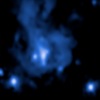 |
 |
Hibernating magnetar springs to life
A mysterious celestial object that emitted 40 visible light flashes before disappearing again is the first object to exhibit a powerful magnetic field and show strong visible light activity, and could be a missing link in the family of neutron stars.
 FULL STORY FULL STORY |
 |
 |
 |
Evidence of life could survive in meteorites
An artificial meteorite designed by the European Space Agency and plunged through the Earth’s atmosphere has shown that traces of life, perhaps entombed within a Martian meteorite, could survive the high temperatures and pressures endured in such an ordeal.
 FULL STORY FULL STORY |
 |
 |
 |
Solar wind at 50 year low
The joint NASA/ESA Ulysses spacecraft has confirmed that the Sun’s solar wind output is at its lowest levels since recordings began, an effect that could see our natural shielding to cosmic rays diminish.
 FULL STORY FULL STORY |
 |
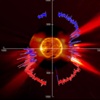 |
 |
Saturn’s rings older
and bigger
New calculations presented at the European Planetary Science Congress (EPSC) this week suggest that Saturn's rings may be more massive and much older than previously thought.
 FULL STORY FULL STORY |
 |
 |
 |
‘Dark flow’ transports galaxies across Universe
Using data from NASA's Wilkinson Microwave Anisotropy Probe (WMAP), scientists have identified a surprising motion in distant galaxy clusters, perhaps caused by the gravitational attraction of matter that lies beyond the observable Universe.
 FULL STORY FULL STORY |
 |
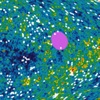 |
 |
Pinning down the Milky Way’s spin
Using ESO’s HARPS instrument, astronomers studying pulsating stars – cepheids – have determined the rotation of our Galaxy, and shown that it is much simpler than previously thought.
 FULL STORY FULL STORY |
 |
 |
 |
Tuning in to Saturn's radio broadcast
Observations from NASA's Cassini spacecraft have been used to build the first three dimensional picture of the sources of intense radio emissions in Saturn's magnetic field, known as the Saturn Kilometric Radiation (SKR).
 FULL STORY FULL STORY |
 |
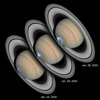 |
 |
Cosmic dust reveals mixed-up Solar System
New analysis of dust from comet Wild 2 is challenging common views about the history and evolution of the Solar System, showing it may be more mixed-up than previously thought.
 FULL STORY FULL STORY |
 |
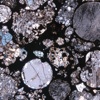 |
 |
Mercury’s ‘spider’ formation linked to asteroid impact
The radiating web of troughs seen emanating from a crater that lies in the bulls-eye of Mercury’s giant Caloris basin was formed by an asteroid impact, say scientists presenting their research at the European Planetary Science Congress today.
 FULL STORY FULL STORY |
 |
 |
 |
Swift sees most distant gamma-ray burst
NASA's Swift satellite has captured a far-flung gamma-ray burst from an exploding star located 12.8 billion light-years away, 70 million light years more distant than the previous record holder.
 FULL STORY FULL STORY |
 |
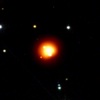 |
 |
Large Hadron Collider powered down in first week
The Large Hadron Collider (LHC) has been forced out of action for at least two months while engineers probe a fault in one section of the tunnel.
 FULL STORY FULL STORY |
 |
 |
 |
Most dark matter dominated galaxy in the Universe
Astronomers using the Keck telescope in Hawaii have revealed a very faint galaxy to be nearly one thousand times more massive than it appears, suggesting that most of its mass must come from dark matter.
 FULL STORY FULL STORY |
 |
 |
 |
Three-dimensional look at Venus’ raging winds
ESA's Venus Express spacecraft, the most powerful atmospheric investigator ever sent to Venus, has put together the first 3D picture of the fierce winds that roar across the planet’s southern hemisphere.
 FULL STORY FULL STORY |
 |
 |
 |
Size doesn't matter for black holes
Periodic X-ray signals are widely observed in low mass black holes, but now, for the first time, XMM-Newton has picked up similar signals from a supermassive black hole, confirming that black holes feed in the same way regardless of their size.
 FULL STORY FULL STORY |
 |
 |
 |
Water present on Mars billion years longer
New research suggests that water may have played a role in shaping parts of the Martian landscape for a billion years longer than previous studies have proposed.
 FULL STORY FULL STORY |
 |
 |
 |
NASA announces new
Mars mission
NASA has selected a mission to Mars that will provide information about the Red Planet's atmosphere, climate history and potential habitability in greater detail than ever before.
 FULL STORY FULL STORY |
 |
 |
 |
Hubble captures rare alignment
Just weeks before Hubble is due for an upgrade, the Hubble team have released this image of a rare alignment between two spiral galaxies, bringing to life the normally invisible tentacles of dust that extend further beyond the visible disc than previously thought.
 FULL STORY FULL STORY |
 |
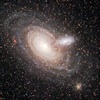 |
 |
Our Sun could be an immigrant star
New simulations suggest that stars such as the Sun can migrate great distances within galaxies like our Milky Way, changing our entire view of how so-called habitable zones can arise in a galactic disc.
 FULL STORY FULL STORY |
 |
 |
 |
First image of planet around Sunlike star
Using the Gemini North telescope on Mauna Kea, astronomers have taken what is likely the first picture of a planet around a ‘normal’ star similar to our Sun.
 FULL STORY FULL STORY |
 |
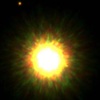 |
 |
Dark matter disc in
our Galaxy
Using the results of a supercomputer simulation, an international team of scientists predict that our Milky Way Galaxy contains a disc of dark matter that could be detected and identified by direct observations.
 FULL STORY FULL STORY |
 |
 |
 |
Dust devils pay visit
to Phoenix
After three months of performing experiments in the north polar regions of Mars, NASA's Phoenix Lander has finally seen dust devils, and sensed a dip in air pressure as one passed nearby.
 FULL STORY FULL STORY |
 |
 |
 |
Naked-eye gamma-ray burst aimed straight
for Earth
Six months ago the brightest gamma-ray burst ever seen from Earth was picked up by the SWIFT telescope, resulting in the rapid scrambling of telescopes all over the world to monitor the fading light, and giving astronomers the most detailed portrait yet of a stellar explosion.
 FULL STORY FULL STORY |
 |
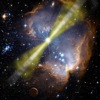 |
 |
Eta Carinae’s eruptions a multi-stage process
Scientists have shown that the outbursts of Eta Carinae, the Milky Way’s biggest, brightest and perhaps most studied star after the Sun, could be driven by an entirely new type of stellar explosion that is fainter than a typical supernova.
 FULL STORY (includes video) FULL STORY (includes video) |
 |
 |
 |
Episodic not catastrophic flooding on Mars
New computer simulations suggest that the massive valley networks that define the surface of Mars could have been carved out by recurrent flooding rather than a short-lived catastrophic event.
 FULL STORY FULL STORY |
 |
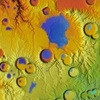 |
 |
Searching for planets in young dust discs
Using ESO’s Very Large Telescope, astronomers have studied the planet-forming discs around young Sunlike stars that may ultimately yield Earthlike planets.
 FULL STORY FULL STORY |
 |
 |
 |
LHC lights up the future of particle physics
At around 09:20 this morning the first beam of particles injected into the Large Hadron Collider successfully completed its maiden voyage around the 27 kilometre track that makes up the world’s biggest ever physics experiment.
 FULL STORY FULL STORY |
 |
 |
 |
New ring arcs orbiting Saturn
NASA’s Cassini spacecraft has spied two separate arcs of material extending ahead of and behind the orbits of Saturn’s small moons Anthe and Methone, likely formed by gravitational disturbances from neighbouring satellite Mimas.
 FULL STORY FULL STORY |
 |
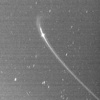 |
 |
Powering up the world’s biggest physics experiment
On Wednesday, the world’s largest particle accelerator – the Large Hadron Collider (LHC) – will be powered up to receive an injection of particle beams for the very first time as it begins the heroic quest to solve some of the biggest mysteries of our Universe.
 FULL STORY FULL STORY |
 |
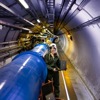 |
 |
Steins “a diamond in
the sky”
Four years into its ten year journey to comet 67/P Churyumov-Gerasimenko, Rosetta completed a successful fly-by of asteroid (2867) Steins at 20:58 CEST on 5 September, only the ninth asteroid to be studied up close by a passing spacecraft.
 FULL STORY FULL STORY |
 |
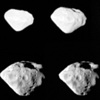 |
 |
Phoenix’s vapour quandary
Although Phoenix has sensed a rise and fall in humidity in the air around the lander, the soil itself is found to be thoroughly and perplexingly dry.
 FULL STORY FULL STORY |
 |
 |
 |
Fine-tooth combing
the Universe
A Nobel Prize-winning technology – a laser frequency ‘comb’ – could bring astronomers a step closer to answering crucial questions about the expanding Universe, and help in the search for extrasolar Earthlike planets.
 FULL STORY FULL STORY |
 |
 |
 |
All eyes on Rosetta for Steins fly-by
The Rosetta control room is buzzing with anticipation as ESA’s comet-chasing spacecraft makes its final preparations for a fly-by of asteroid (2867) Steins on the evening of 5 September.
 FULL STORY FULL STORY |
 |
 |
 |
Observations of a Milky Way look-alike
ESO's Wide Field Imager (WFI), attached to the 2.2 metre Max-Planck Society/ESO telescope in Chile, has captured the intricate swirls of the barred spiral galaxy Messier 83, a smaller version of our own Milky Way.
 FULL STORY FULL STORY |
 |
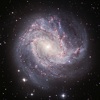 |
 |
Comets disguised
as asteroids
Planetary scientists have discovered that between five and ten percent of Near Earth Objects could be comets impersonating asteroids, and plan to find ways to reveal their true identity.
 FULL STORY FULL STORY |
 |
 |
 |
Getting closer to the Milky Way’s black hole
By combining telescopes in Hawaii, Arizona and California, a team of astronomers have stared deep into the heart of the supermassive black hole that is thought to lurk at the centre of our own Milky Way Galaxy.
 FULL STORY FULL STORY |
 |
 |
 |
Life after death in the
Crab Nebula
A team of scientists lead by Professor Tony Dean of the University of Southampton has detected polarized gamma-ray emission from the vicinity of the Crab Nebula, providing insight into the processes that bring a dead star to life.
 FULL STORY FULL STORY |
 |
 |
 |
Building the biggest galaxies
Astronomers have caught multiple massive galaxies in the act of merging about 4 billion years ago, supporting the favoured ‘hierarchical’ theory of how galaxies form.
 FULL STORY FULL STORY |
 |
 |
 |
 |

Back to latest news |
 |

